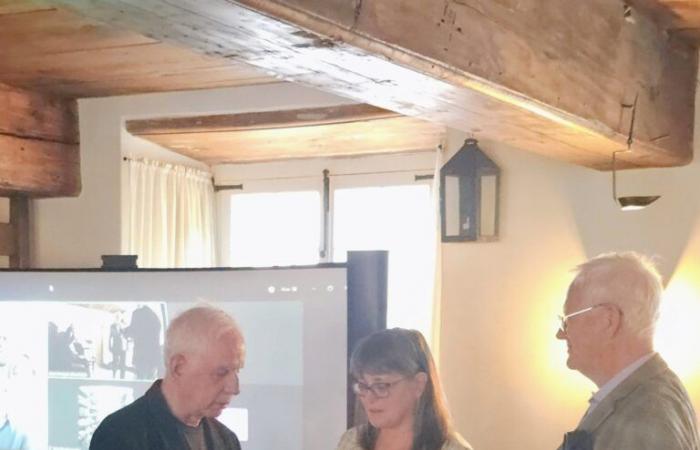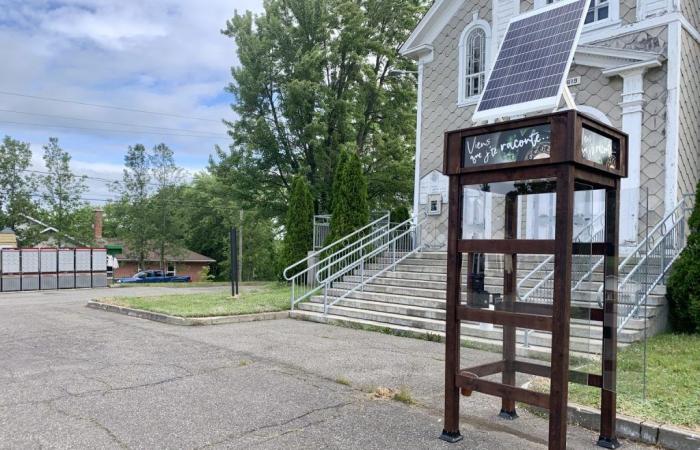Sophie Poulin de Courval, from Saint-Joseph-de-Kamouraska, recently received an honorable mention from the Jean-Simard prize for her project Come let me tell you. The initiative immerses residents and visitors in the stories of its village, thanks to a telephone booth where stories of the past come to life.
“By rewarding projects like Sophie’s, we highlight an essential human and collective heritage,” underlined Jean-François Blanchette, president of the Société québécoise d’ethnologie. The man is recognized for his commitment to the preservation and enhancement of Quebec’s cultural heritage.
This recognition, awarded to Ms. Poulin de Courval during a ceremony at the Mauvide-Genest mansion in Saint-Jean-de-l’Île-d’Orléans, honors an ethnological approach that goes beyond the simple collection of stories. “By installing a telephone booth in her village of Saint-Joseph-de-Kamouraska, Sophie Poulin de Courval allowed visitors to go further. When they pick up the receiver, they listen to five local anecdotes, some tragic, others joyful, but all anchored in the collective memory of the region, and told by real witnesses,” we read in the price description.
The idea, simple in appearance, won over the jury with its participatory approach. “I wanted people to rediscover a little of the magic of the evenings of yesteryear, where we gathered to listen to stories,” explains Sophie. In each cabin, a recorded voice – that of a resident or a witness – tells a story summarized in one minute and a half. This interactive aspect of the work, combined with a playful dimension, encouraged a reappropriation of the stories by the residents of Saint-Joseph-de-Kamouraska.
Enriched heritage
This honorable mention from the Jean-Simard Prize also highlights the social impact of the project, which gives residents fragments of their own history, at a time when these memories sometimes tend to fade. “This return of knowledge to the community is an approach that enriches both the heritage and the people who inherit it,” explained Jean-François Blanchette.
In addition to the honorable mention of Sophie’s project, the first prize was won by the Cultural Center of the Ursuline Monastery of Quebec, for the experience Echoes of the choir.
Come let me tell you could be exported
Sophie Poulin de Courval speaks with enthusiasm about what led her to set up her project Come let me tell you. The awards and recognition she has won since its creation, as well as her popular success, encourage her to want to export her concept.
“I am surprised, but also very happy and proud to see the enthusiasm for my project, which today goes beyond the borders of Saint-Joseph-de-Kamouraska. It would be nice if each village had its own cabin, a place where we could listen to the voices of the past,” imagines the trained saxophonist.
The idea of the telephone booth came to Sophie Poulin de Courval when she saw the gradual disappearance of this symbol once so common in Quebec landscapes. In Saint-Joseph-de-Kamouraska, an old Bell cabin still stood in the heart of the village, a vestige of a time when it served as a direct link between the inhabitants and the rest of the world.
That’s where the idea came from. Unfortunately, between the initial flash and the assembly of the project, the cabin was removed. “I found myself with my mouth to water,” she said, admitting in the same breath that the disappearance of the cabin gave even more importance to her idea, since it constituted another important part of the collective memory. , who also flew away with her.
A woman with infinite resources, Sophie decided to build her own cabin, using local resources, including wood from Saint-Joseph-de-Kamouraska, a way of strengthening the link between this new installation and its environment.
By integrating recordings of stories told by residents, she transformed the cabin into a sort of time capsule, where each passage of a listener becomes an intimate encounter with the living heritage of the village. This concept became the heart of the project Come let me tell youwith the cabin serving as a place for intergenerational exchange, allowing visitors to listen and relive unique stories, while connecting to local roots and culture, close to a meaningful place, the front steps of the church, where these stories were formerly shared.
Poignant stories of daily life, anecdotes about the seasons, or even tragedies that have marked the community find new life in this telephone box. “It was important for me to respect the voices and accents, even if some were not comfortable with the microphone. This is also the real heritage,” she adds.
Pushing perfection to the extreme, the cabin is equipped to reproduce the acoustics of vintage telephones, offering listeners a unique sound immersion. The approach even caught the attention of -, which presented the project in a national broadcast, highlighting this original way of bringing Quebec’s oral heritage to life.
Until this project finds resonance in other municipalities, the Municipality of Saint-Joseph is evaluating the possibility of putting the cabin back in place next summer.







